An Analysis of International Tourism and Hospitality in Kerala
VerifiedAdded on 2021/06/17
|11
|2449
|52
Report
AI Summary
This report provides a comprehensive overview of the international tourism and hospitality industry in Kerala, India. It delves into the historical context, highlighting Kerala's reputation as a leading tourist destination and its significant economic contributions. The report examines the challenges faced by the tourism sector, including infrastructural limitations, civic issues, and the impact of tourism on local communities. It analyzes various research articles to understand the issues related to accommodation, accessibility, and language barriers faced by tourists. Furthermore, the report explores the socio-cultural impacts of tourism, both positive and negative, on the local residents. It also discusses the initiatives of responsible and community-based tourism, emphasizing their economic, social, and environmental benefits. The report concludes by highlighting the importance of sustainable practices and the need for government policies to support the tourism sector's growth while mitigating negative impacts. The analysis includes insights into the role of internal stakeholders, the importance of infrastructure development, and the preservation of local culture and traditions. This report uses multiple sources and provides a holistic view of the complex dynamics within Kerala's tourism industry.
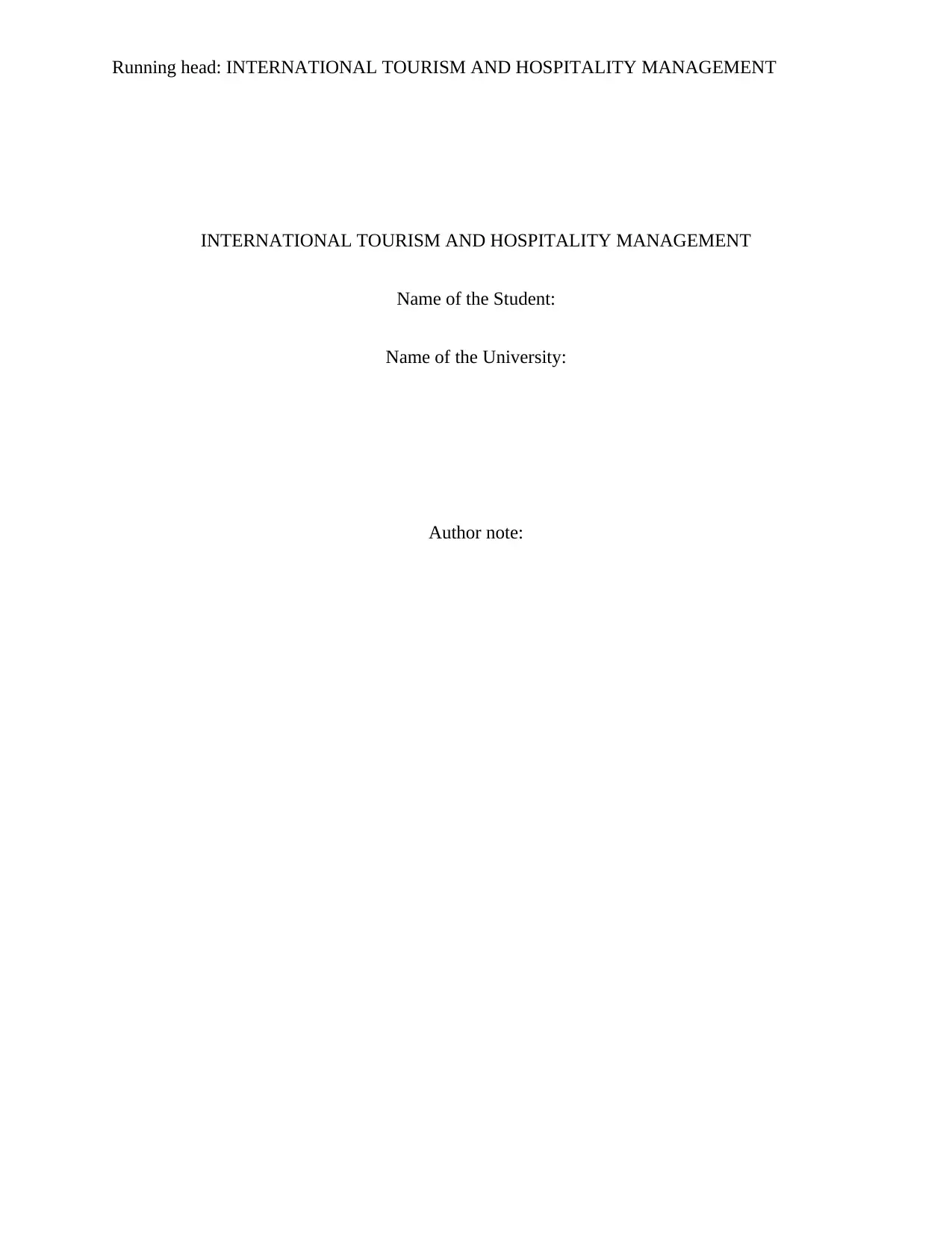
Running head: INTERNATIONAL TOURISM AND HOSPITALITY MANAGEMENT
INTERNATIONAL TOURISM AND HOSPITALITY MANAGEMENT
Name of the Student:
Name of the University:
Author note:
INTERNATIONAL TOURISM AND HOSPITALITY MANAGEMENT
Name of the Student:
Name of the University:
Author note:
Secure Best Marks with AI Grader
Need help grading? Try our AI Grader for instant feedback on your assignments.
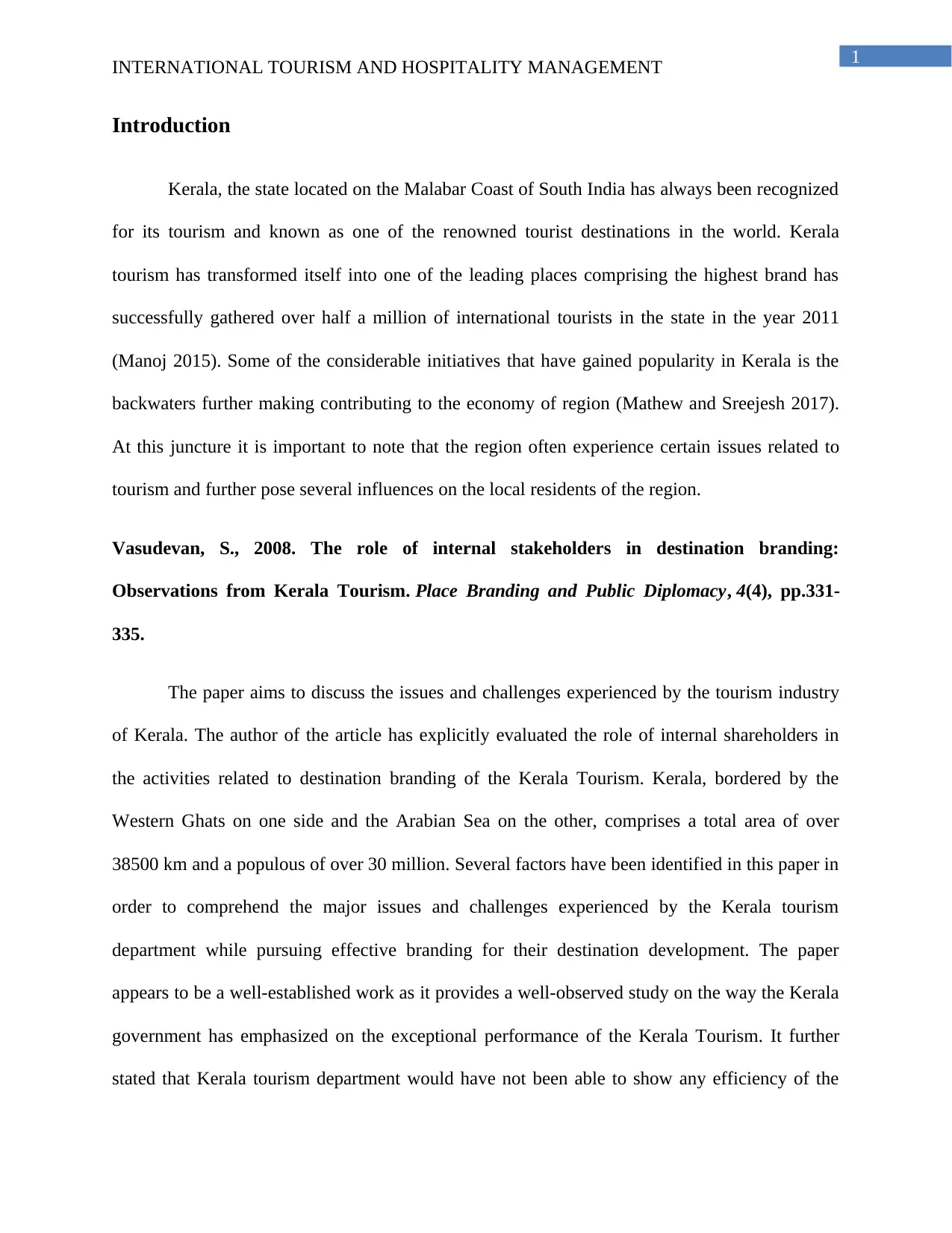
1
INTERNATIONAL TOURISM AND HOSPITALITY MANAGEMENT
Introduction
Kerala, the state located on the Malabar Coast of South India has always been recognized
for its tourism and known as one of the renowned tourist destinations in the world. Kerala
tourism has transformed itself into one of the leading places comprising the highest brand has
successfully gathered over half a million of international tourists in the state in the year 2011
(Manoj 2015). Some of the considerable initiatives that have gained popularity in Kerala is the
backwaters further making contributing to the economy of region (Mathew and Sreejesh 2017).
At this juncture it is important to note that the region often experience certain issues related to
tourism and further pose several influences on the local residents of the region.
Vasudevan, S., 2008. The role of internal stakeholders in destination branding:
Observations from Kerala Tourism. Place Branding and Public Diplomacy, 4(4), pp.331-
335.
The paper aims to discuss the issues and challenges experienced by the tourism industry
of Kerala. The author of the article has explicitly evaluated the role of internal shareholders in
the activities related to destination branding of the Kerala Tourism. Kerala, bordered by the
Western Ghats on one side and the Arabian Sea on the other, comprises a total area of over
38500 km and a populous of over 30 million. Several factors have been identified in this paper in
order to comprehend the major issues and challenges experienced by the Kerala tourism
department while pursuing effective branding for their destination development. The paper
appears to be a well-established work as it provides a well-observed study on the way the Kerala
government has emphasized on the exceptional performance of the Kerala Tourism. It further
stated that Kerala tourism department would have not been able to show any efficiency of the
INTERNATIONAL TOURISM AND HOSPITALITY MANAGEMENT
Introduction
Kerala, the state located on the Malabar Coast of South India has always been recognized
for its tourism and known as one of the renowned tourist destinations in the world. Kerala
tourism has transformed itself into one of the leading places comprising the highest brand has
successfully gathered over half a million of international tourists in the state in the year 2011
(Manoj 2015). Some of the considerable initiatives that have gained popularity in Kerala is the
backwaters further making contributing to the economy of region (Mathew and Sreejesh 2017).
At this juncture it is important to note that the region often experience certain issues related to
tourism and further pose several influences on the local residents of the region.
Vasudevan, S., 2008. The role of internal stakeholders in destination branding:
Observations from Kerala Tourism. Place Branding and Public Diplomacy, 4(4), pp.331-
335.
The paper aims to discuss the issues and challenges experienced by the tourism industry
of Kerala. The author of the article has explicitly evaluated the role of internal shareholders in
the activities related to destination branding of the Kerala Tourism. Kerala, bordered by the
Western Ghats on one side and the Arabian Sea on the other, comprises a total area of over
38500 km and a populous of over 30 million. Several factors have been identified in this paper in
order to comprehend the major issues and challenges experienced by the Kerala tourism
department while pursuing effective branding for their destination development. The paper
appears to be a well-established work as it provides a well-observed study on the way the Kerala
government has emphasized on the exceptional performance of the Kerala Tourism. It further
stated that Kerala tourism department would have not been able to show any efficiency of the
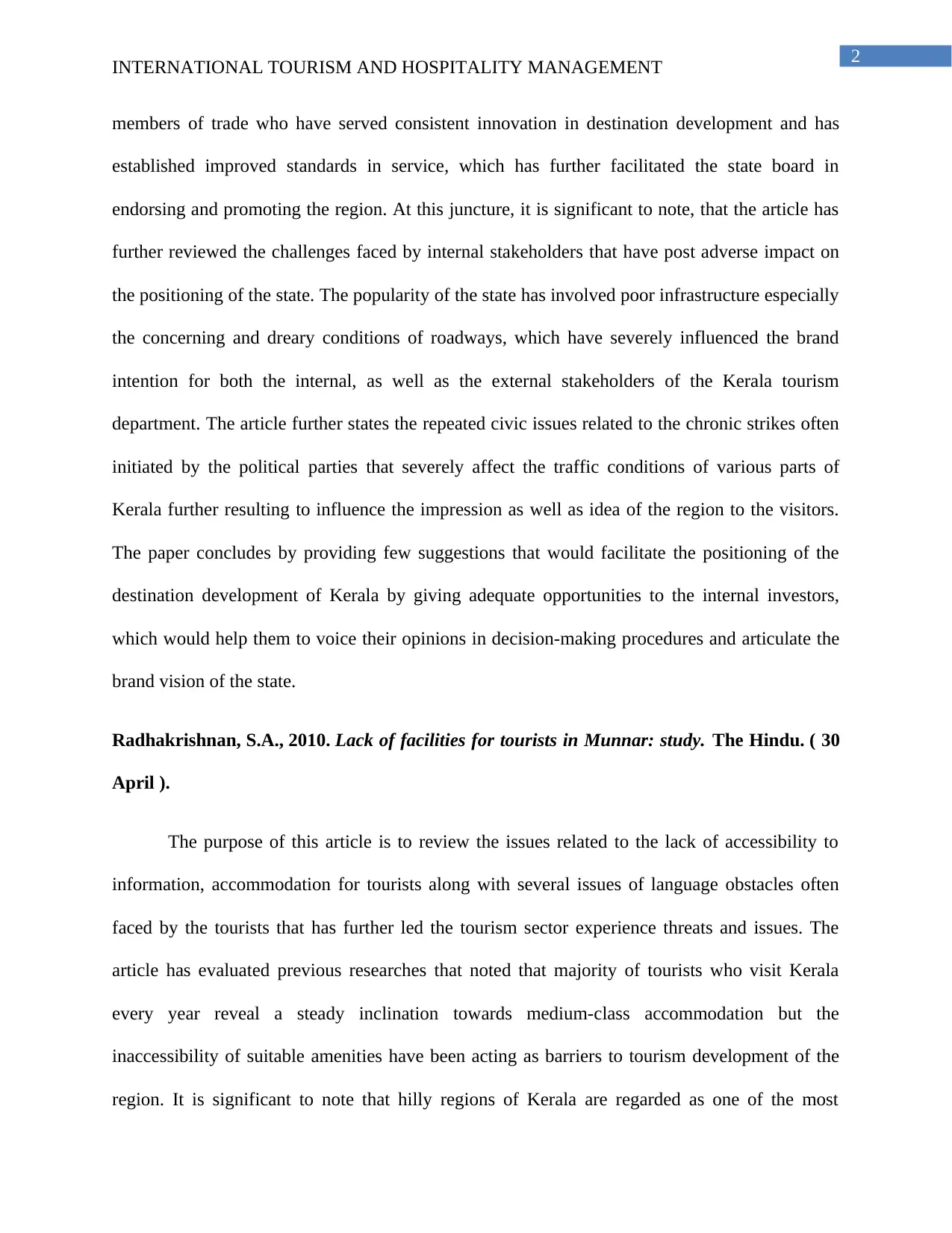
2
INTERNATIONAL TOURISM AND HOSPITALITY MANAGEMENT
members of trade who have served consistent innovation in destination development and has
established improved standards in service, which has further facilitated the state board in
endorsing and promoting the region. At this juncture, it is significant to note, that the article has
further reviewed the challenges faced by internal stakeholders that have post adverse impact on
the positioning of the state. The popularity of the state has involved poor infrastructure especially
the concerning and dreary conditions of roadways, which have severely influenced the brand
intention for both the internal, as well as the external stakeholders of the Kerala tourism
department. The article further states the repeated civic issues related to the chronic strikes often
initiated by the political parties that severely affect the traffic conditions of various parts of
Kerala further resulting to influence the impression as well as idea of the region to the visitors.
The paper concludes by providing few suggestions that would facilitate the positioning of the
destination development of Kerala by giving adequate opportunities to the internal investors,
which would help them to voice their opinions in decision-making procedures and articulate the
brand vision of the state.
Radhakrishnan, S.A., 2010. Lack of facilities for tourists in Munnar: study. The Hindu. ( 30
April ).
The purpose of this article is to review the issues related to the lack of accessibility to
information, accommodation for tourists along with several issues of language obstacles often
faced by the tourists that has further led the tourism sector experience threats and issues. The
article has evaluated previous researches that noted that majority of tourists who visit Kerala
every year reveal a steady inclination towards medium-class accommodation but the
inaccessibility of suitable amenities have been acting as barriers to tourism development of the
region. It is significant to note that hilly regions of Kerala are regarded as one of the most
INTERNATIONAL TOURISM AND HOSPITALITY MANAGEMENT
members of trade who have served consistent innovation in destination development and has
established improved standards in service, which has further facilitated the state board in
endorsing and promoting the region. At this juncture, it is significant to note, that the article has
further reviewed the challenges faced by internal stakeholders that have post adverse impact on
the positioning of the state. The popularity of the state has involved poor infrastructure especially
the concerning and dreary conditions of roadways, which have severely influenced the brand
intention for both the internal, as well as the external stakeholders of the Kerala tourism
department. The article further states the repeated civic issues related to the chronic strikes often
initiated by the political parties that severely affect the traffic conditions of various parts of
Kerala further resulting to influence the impression as well as idea of the region to the visitors.
The paper concludes by providing few suggestions that would facilitate the positioning of the
destination development of Kerala by giving adequate opportunities to the internal investors,
which would help them to voice their opinions in decision-making procedures and articulate the
brand vision of the state.
Radhakrishnan, S.A., 2010. Lack of facilities for tourists in Munnar: study. The Hindu. ( 30
April ).
The purpose of this article is to review the issues related to the lack of accessibility to
information, accommodation for tourists along with several issues of language obstacles often
faced by the tourists that has further led the tourism sector experience threats and issues. The
article has evaluated previous researches that noted that majority of tourists who visit Kerala
every year reveal a steady inclination towards medium-class accommodation but the
inaccessibility of suitable amenities have been acting as barriers to tourism development of the
region. It is significant to note that hilly regions of Kerala are regarded as one of the most
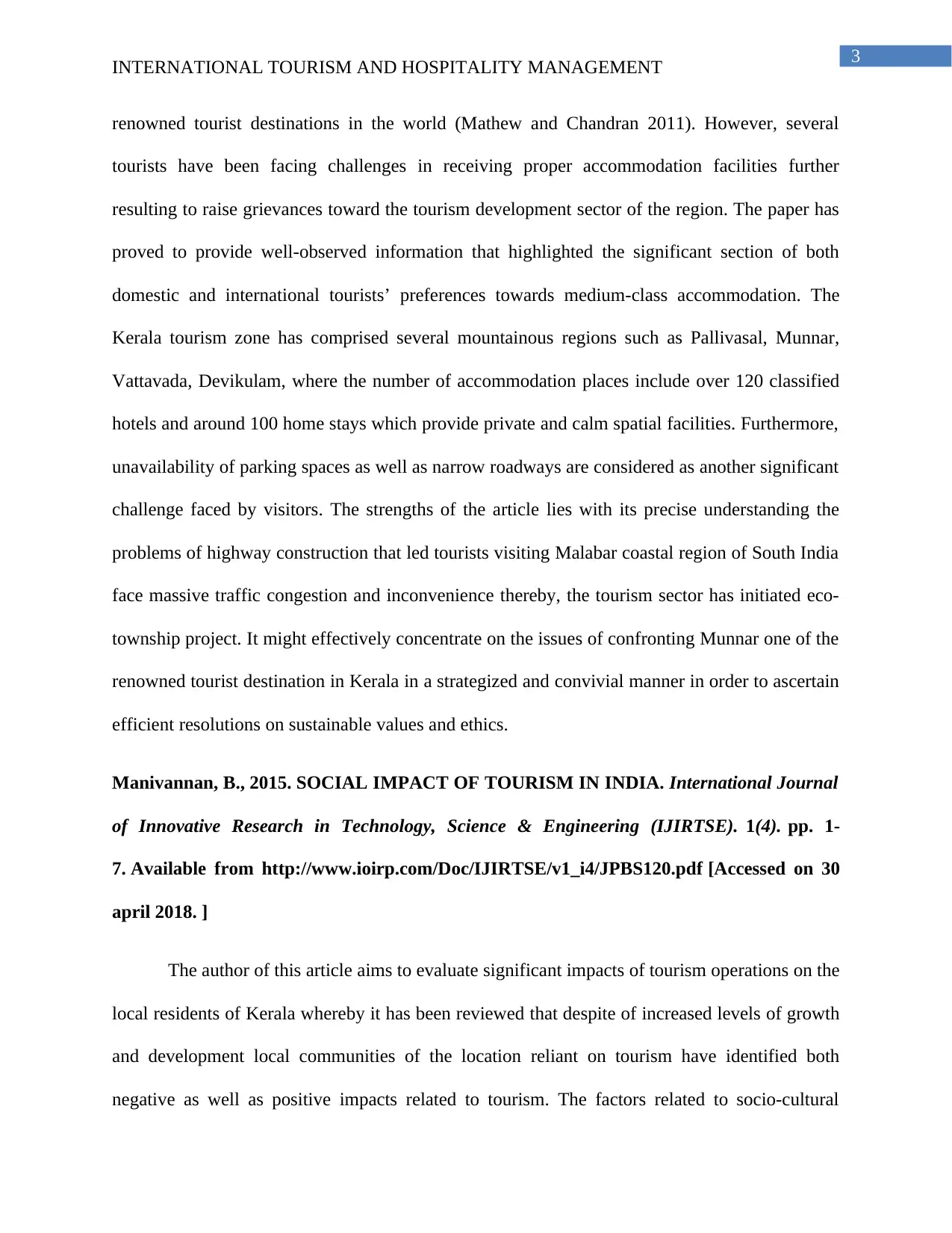
3
INTERNATIONAL TOURISM AND HOSPITALITY MANAGEMENT
renowned tourist destinations in the world (Mathew and Chandran 2011). However, several
tourists have been facing challenges in receiving proper accommodation facilities further
resulting to raise grievances toward the tourism development sector of the region. The paper has
proved to provide well-observed information that highlighted the significant section of both
domestic and international tourists’ preferences towards medium-class accommodation. The
Kerala tourism zone has comprised several mountainous regions such as Pallivasal, Munnar,
Vattavada, Devikulam, where the number of accommodation places include over 120 classified
hotels and around 100 home stays which provide private and calm spatial facilities. Furthermore,
unavailability of parking spaces as well as narrow roadways are considered as another significant
challenge faced by visitors. The strengths of the article lies with its precise understanding the
problems of highway construction that led tourists visiting Malabar coastal region of South India
face massive traffic congestion and inconvenience thereby, the tourism sector has initiated eco-
township project. It might effectively concentrate on the issues of confronting Munnar one of the
renowned tourist destination in Kerala in a strategized and convivial manner in order to ascertain
efficient resolutions on sustainable values and ethics.
Manivannan, B., 2015. SOCIAL IMPACT OF TOURISM IN INDIA. International Journal
of Innovative Research in Technology, Science & Engineering (IJIRTSE). 1(4). pp. 1-
7. Available from http://www.ioirp.com/Doc/IJIRTSE/v1_i4/JPBS120.pdf [Accessed on 30
april 2018. ]
The author of this article aims to evaluate significant impacts of tourism operations on the
local residents of Kerala whereby it has been reviewed that despite of increased levels of growth
and development local communities of the location reliant on tourism have identified both
negative as well as positive impacts related to tourism. The factors related to socio-cultural
INTERNATIONAL TOURISM AND HOSPITALITY MANAGEMENT
renowned tourist destinations in the world (Mathew and Chandran 2011). However, several
tourists have been facing challenges in receiving proper accommodation facilities further
resulting to raise grievances toward the tourism development sector of the region. The paper has
proved to provide well-observed information that highlighted the significant section of both
domestic and international tourists’ preferences towards medium-class accommodation. The
Kerala tourism zone has comprised several mountainous regions such as Pallivasal, Munnar,
Vattavada, Devikulam, where the number of accommodation places include over 120 classified
hotels and around 100 home stays which provide private and calm spatial facilities. Furthermore,
unavailability of parking spaces as well as narrow roadways are considered as another significant
challenge faced by visitors. The strengths of the article lies with its precise understanding the
problems of highway construction that led tourists visiting Malabar coastal region of South India
face massive traffic congestion and inconvenience thereby, the tourism sector has initiated eco-
township project. It might effectively concentrate on the issues of confronting Munnar one of the
renowned tourist destination in Kerala in a strategized and convivial manner in order to ascertain
efficient resolutions on sustainable values and ethics.
Manivannan, B., 2015. SOCIAL IMPACT OF TOURISM IN INDIA. International Journal
of Innovative Research in Technology, Science & Engineering (IJIRTSE). 1(4). pp. 1-
7. Available from http://www.ioirp.com/Doc/IJIRTSE/v1_i4/JPBS120.pdf [Accessed on 30
april 2018. ]
The author of this article aims to evaluate significant impacts of tourism operations on the
local residents of Kerala whereby it has been reviewed that despite of increased levels of growth
and development local communities of the location reliant on tourism have identified both
negative as well as positive impacts related to tourism. The factors related to socio-cultural
Secure Best Marks with AI Grader
Need help grading? Try our AI Grader for instant feedback on your assignments.
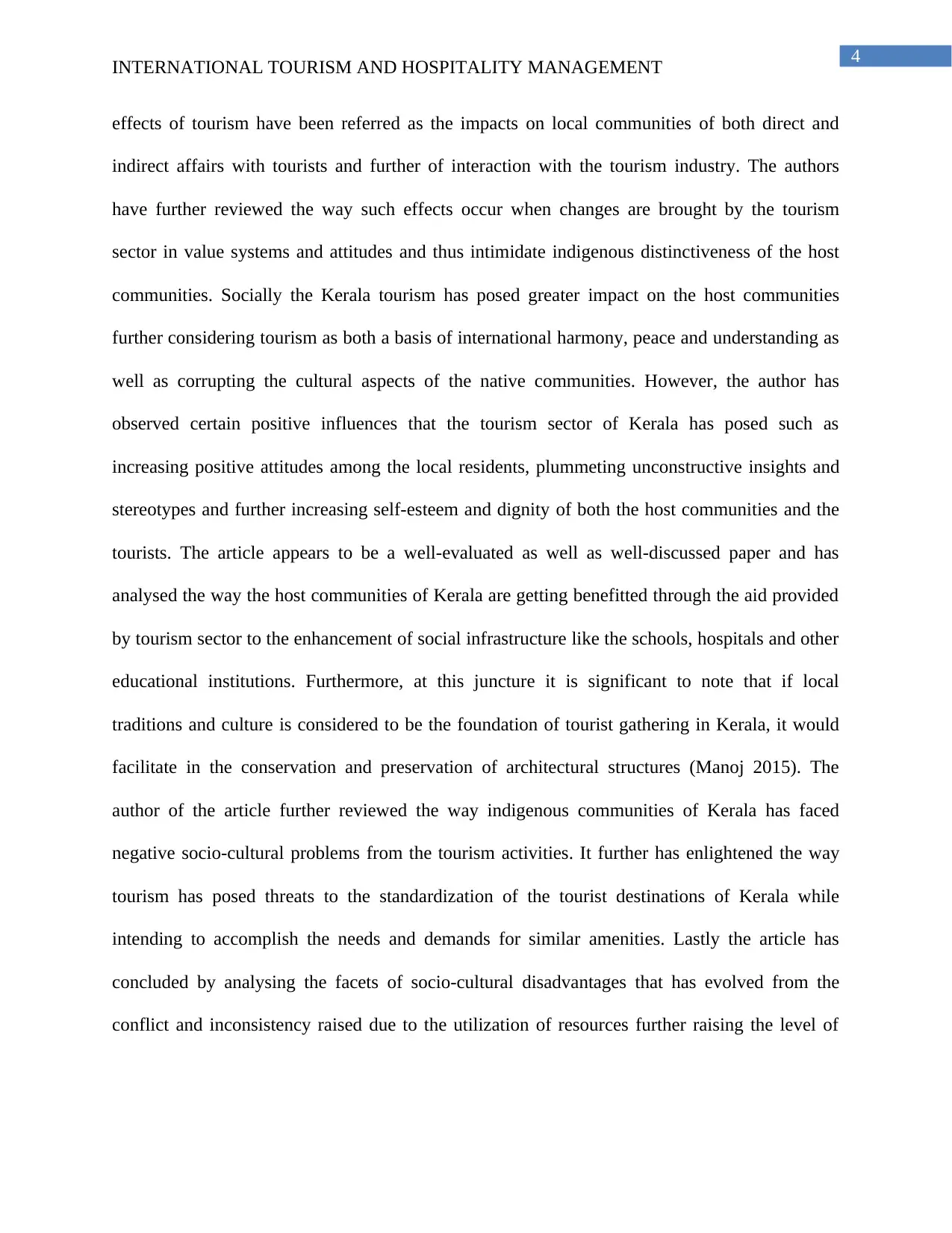
4
INTERNATIONAL TOURISM AND HOSPITALITY MANAGEMENT
effects of tourism have been referred as the impacts on local communities of both direct and
indirect affairs with tourists and further of interaction with the tourism industry. The authors
have further reviewed the way such effects occur when changes are brought by the tourism
sector in value systems and attitudes and thus intimidate indigenous distinctiveness of the host
communities. Socially the Kerala tourism has posed greater impact on the host communities
further considering tourism as both a basis of international harmony, peace and understanding as
well as corrupting the cultural aspects of the native communities. However, the author has
observed certain positive influences that the tourism sector of Kerala has posed such as
increasing positive attitudes among the local residents, plummeting unconstructive insights and
stereotypes and further increasing self-esteem and dignity of both the host communities and the
tourists. The article appears to be a well-evaluated as well as well-discussed paper and has
analysed the way the host communities of Kerala are getting benefitted through the aid provided
by tourism sector to the enhancement of social infrastructure like the schools, hospitals and other
educational institutions. Furthermore, at this juncture it is significant to note that if local
traditions and culture is considered to be the foundation of tourist gathering in Kerala, it would
facilitate in the conservation and preservation of architectural structures (Manoj 2015). The
author of the article further reviewed the way indigenous communities of Kerala has faced
negative socio-cultural problems from the tourism activities. It further has enlightened the way
tourism has posed threats to the standardization of the tourist destinations of Kerala while
intending to accomplish the needs and demands for similar amenities. Lastly the article has
concluded by analysing the facets of socio-cultural disadvantages that has evolved from the
conflict and inconsistency raised due to the utilization of resources further raising the level of
INTERNATIONAL TOURISM AND HOSPITALITY MANAGEMENT
effects of tourism have been referred as the impacts on local communities of both direct and
indirect affairs with tourists and further of interaction with the tourism industry. The authors
have further reviewed the way such effects occur when changes are brought by the tourism
sector in value systems and attitudes and thus intimidate indigenous distinctiveness of the host
communities. Socially the Kerala tourism has posed greater impact on the host communities
further considering tourism as both a basis of international harmony, peace and understanding as
well as corrupting the cultural aspects of the native communities. However, the author has
observed certain positive influences that the tourism sector of Kerala has posed such as
increasing positive attitudes among the local residents, plummeting unconstructive insights and
stereotypes and further increasing self-esteem and dignity of both the host communities and the
tourists. The article appears to be a well-evaluated as well as well-discussed paper and has
analysed the way the host communities of Kerala are getting benefitted through the aid provided
by tourism sector to the enhancement of social infrastructure like the schools, hospitals and other
educational institutions. Furthermore, at this juncture it is significant to note that if local
traditions and culture is considered to be the foundation of tourist gathering in Kerala, it would
facilitate in the conservation and preservation of architectural structures (Manoj 2015). The
author of the article further reviewed the way indigenous communities of Kerala has faced
negative socio-cultural problems from the tourism activities. It further has enlightened the way
tourism has posed threats to the standardization of the tourist destinations of Kerala while
intending to accomplish the needs and demands for similar amenities. Lastly the article has
concluded by analysing the facets of socio-cultural disadvantages that has evolved from the
conflict and inconsistency raised due to the utilization of resources further raising the level of
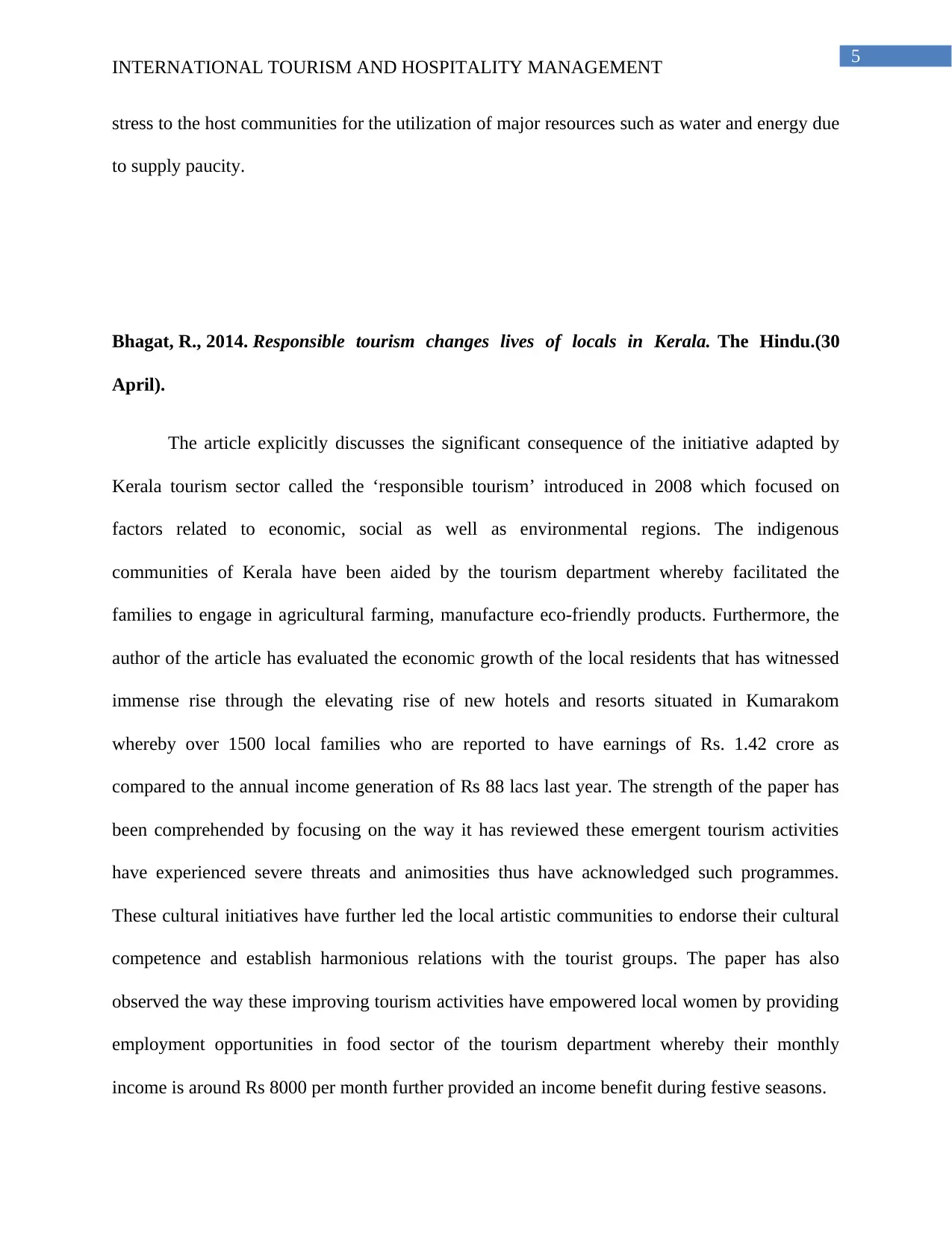
5
INTERNATIONAL TOURISM AND HOSPITALITY MANAGEMENT
stress to the host communities for the utilization of major resources such as water and energy due
to supply paucity.
Bhagat, R., 2014. Responsible tourism changes lives of locals in Kerala. The Hindu.(30
April).
The article explicitly discusses the significant consequence of the initiative adapted by
Kerala tourism sector called the ‘responsible tourism’ introduced in 2008 which focused on
factors related to economic, social as well as environmental regions. The indigenous
communities of Kerala have been aided by the tourism department whereby facilitated the
families to engage in agricultural farming, manufacture eco-friendly products. Furthermore, the
author of the article has evaluated the economic growth of the local residents that has witnessed
immense rise through the elevating rise of new hotels and resorts situated in Kumarakom
whereby over 1500 local families who are reported to have earnings of Rs. 1.42 crore as
compared to the annual income generation of Rs 88 lacs last year. The strength of the paper has
been comprehended by focusing on the way it has reviewed these emergent tourism activities
have experienced severe threats and animosities thus have acknowledged such programmes.
These cultural initiatives have further led the local artistic communities to endorse their cultural
competence and establish harmonious relations with the tourist groups. The paper has also
observed the way these improving tourism activities have empowered local women by providing
employment opportunities in food sector of the tourism department whereby their monthly
income is around Rs 8000 per month further provided an income benefit during festive seasons.
INTERNATIONAL TOURISM AND HOSPITALITY MANAGEMENT
stress to the host communities for the utilization of major resources such as water and energy due
to supply paucity.
Bhagat, R., 2014. Responsible tourism changes lives of locals in Kerala. The Hindu.(30
April).
The article explicitly discusses the significant consequence of the initiative adapted by
Kerala tourism sector called the ‘responsible tourism’ introduced in 2008 which focused on
factors related to economic, social as well as environmental regions. The indigenous
communities of Kerala have been aided by the tourism department whereby facilitated the
families to engage in agricultural farming, manufacture eco-friendly products. Furthermore, the
author of the article has evaluated the economic growth of the local residents that has witnessed
immense rise through the elevating rise of new hotels and resorts situated in Kumarakom
whereby over 1500 local families who are reported to have earnings of Rs. 1.42 crore as
compared to the annual income generation of Rs 88 lacs last year. The strength of the paper has
been comprehended by focusing on the way it has reviewed these emergent tourism activities
have experienced severe threats and animosities thus have acknowledged such programmes.
These cultural initiatives have further led the local artistic communities to endorse their cultural
competence and establish harmonious relations with the tourist groups. The paper has also
observed the way these improving tourism activities have empowered local women by providing
employment opportunities in food sector of the tourism department whereby their monthly
income is around Rs 8000 per month further provided an income benefit during festive seasons.

6
INTERNATIONAL TOURISM AND HOSPITALITY MANAGEMENT
INTERNATIONAL TOURISM AND HOSPITALITY MANAGEMENT
Paraphrase This Document
Need a fresh take? Get an instant paraphrase of this document with our AI Paraphraser
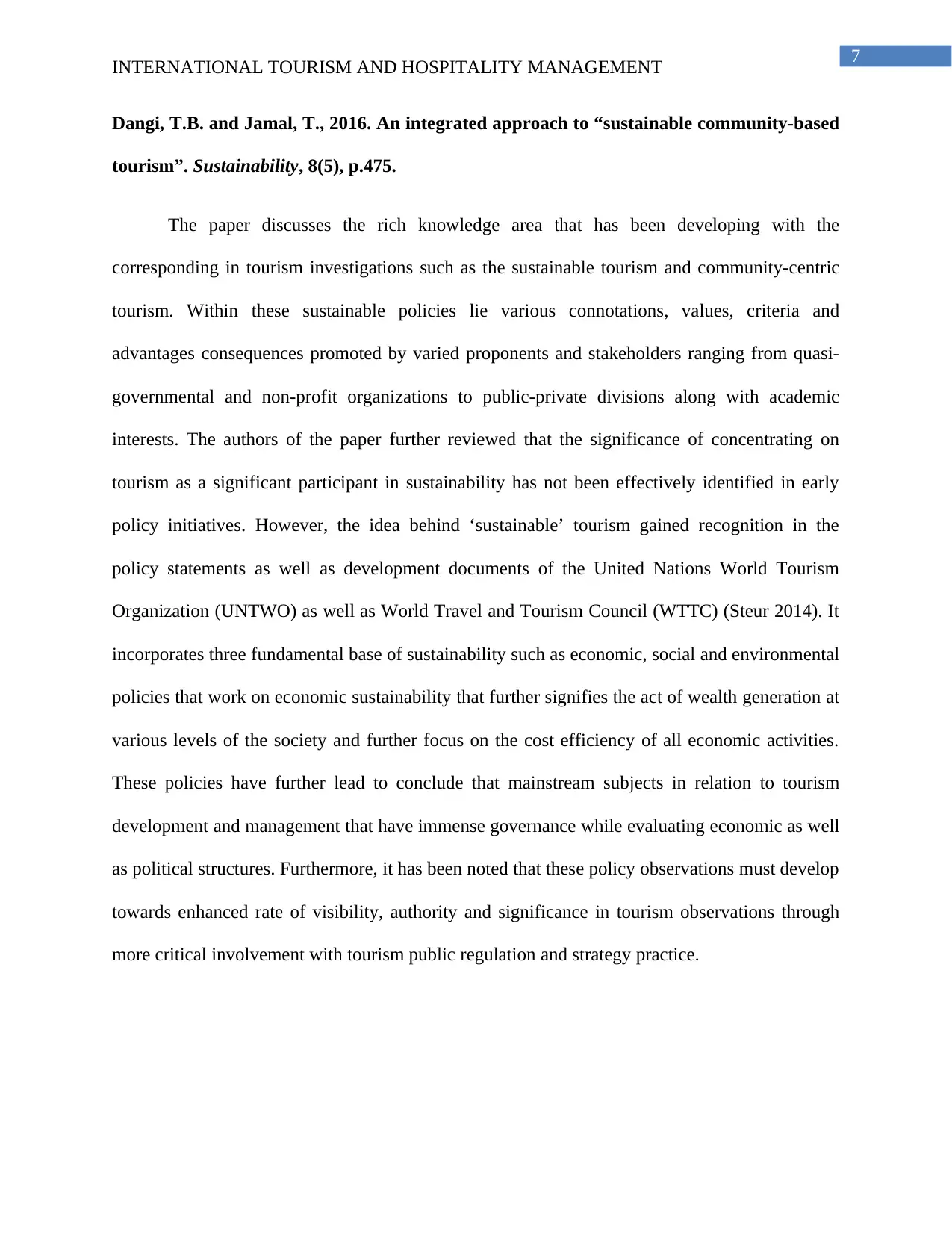
7
INTERNATIONAL TOURISM AND HOSPITALITY MANAGEMENT
Dangi, T.B. and Jamal, T., 2016. An integrated approach to “sustainable community-based
tourism”. Sustainability, 8(5), p.475.
The paper discusses the rich knowledge area that has been developing with the
corresponding in tourism investigations such as the sustainable tourism and community-centric
tourism. Within these sustainable policies lie various connotations, values, criteria and
advantages consequences promoted by varied proponents and stakeholders ranging from quasi-
governmental and non-profit organizations to public-private divisions along with academic
interests. The authors of the paper further reviewed that the significance of concentrating on
tourism as a significant participant in sustainability has not been effectively identified in early
policy initiatives. However, the idea behind ‘sustainable’ tourism gained recognition in the
policy statements as well as development documents of the United Nations World Tourism
Organization (UNTWO) as well as World Travel and Tourism Council (WTTC) (Steur 2014). It
incorporates three fundamental base of sustainability such as economic, social and environmental
policies that work on economic sustainability that further signifies the act of wealth generation at
various levels of the society and further focus on the cost efficiency of all economic activities.
These policies have further lead to conclude that mainstream subjects in relation to tourism
development and management that have immense governance while evaluating economic as well
as political structures. Furthermore, it has been noted that these policy observations must develop
towards enhanced rate of visibility, authority and significance in tourism observations through
more critical involvement with tourism public regulation and strategy practice.
INTERNATIONAL TOURISM AND HOSPITALITY MANAGEMENT
Dangi, T.B. and Jamal, T., 2016. An integrated approach to “sustainable community-based
tourism”. Sustainability, 8(5), p.475.
The paper discusses the rich knowledge area that has been developing with the
corresponding in tourism investigations such as the sustainable tourism and community-centric
tourism. Within these sustainable policies lie various connotations, values, criteria and
advantages consequences promoted by varied proponents and stakeholders ranging from quasi-
governmental and non-profit organizations to public-private divisions along with academic
interests. The authors of the paper further reviewed that the significance of concentrating on
tourism as a significant participant in sustainability has not been effectively identified in early
policy initiatives. However, the idea behind ‘sustainable’ tourism gained recognition in the
policy statements as well as development documents of the United Nations World Tourism
Organization (UNTWO) as well as World Travel and Tourism Council (WTTC) (Steur 2014). It
incorporates three fundamental base of sustainability such as economic, social and environmental
policies that work on economic sustainability that further signifies the act of wealth generation at
various levels of the society and further focus on the cost efficiency of all economic activities.
These policies have further lead to conclude that mainstream subjects in relation to tourism
development and management that have immense governance while evaluating economic as well
as political structures. Furthermore, it has been noted that these policy observations must develop
towards enhanced rate of visibility, authority and significance in tourism observations through
more critical involvement with tourism public regulation and strategy practice.
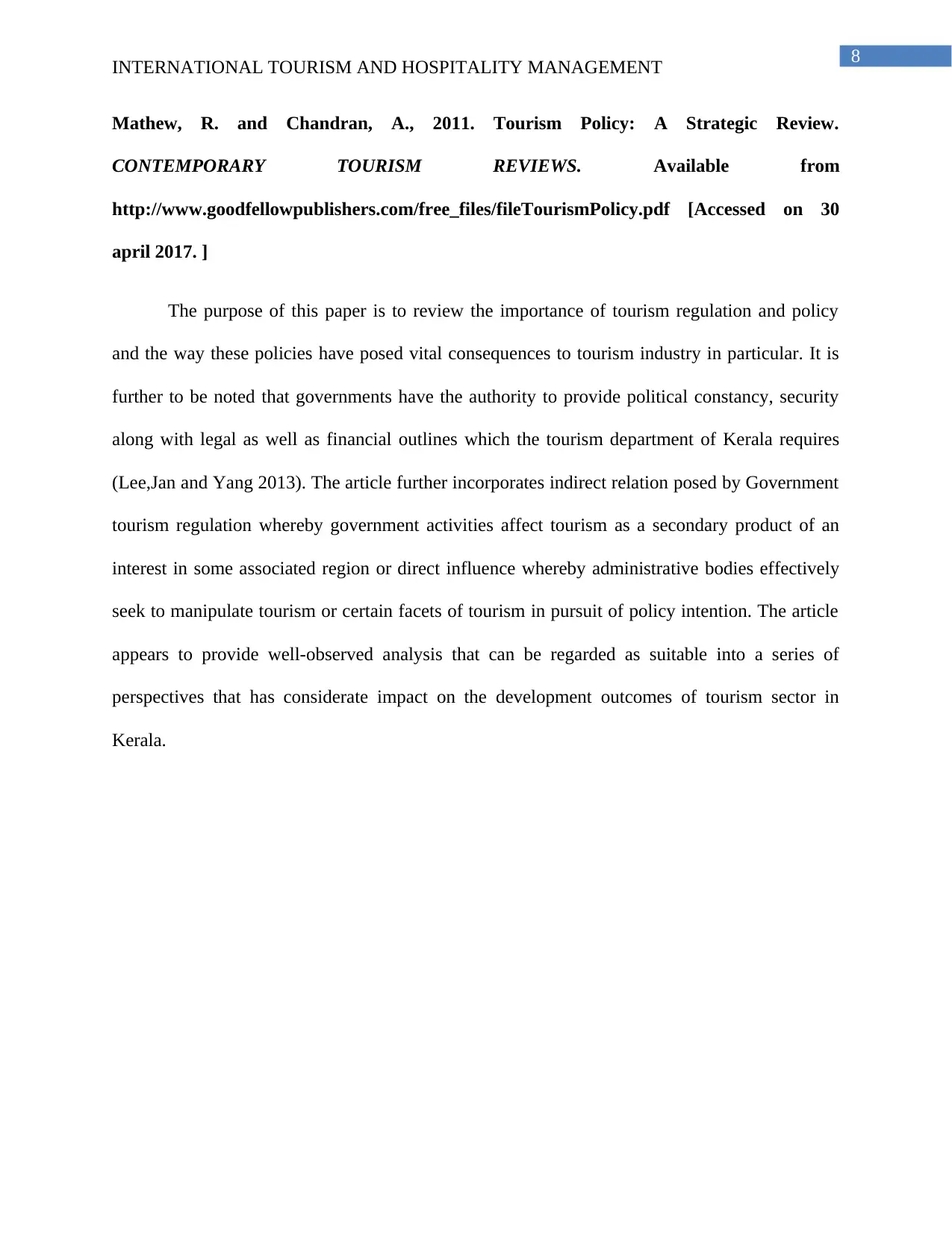
8
INTERNATIONAL TOURISM AND HOSPITALITY MANAGEMENT
Mathew, R. and Chandran, A., 2011. Tourism Policy: A Strategic Review.
CONTEMPORARY TOURISM REVIEWS. Available from
http://www.goodfellowpublishers.com/free_files/fileTourismPolicy.pdf [Accessed on 30
april 2017. ]
The purpose of this paper is to review the importance of tourism regulation and policy
and the way these policies have posed vital consequences to tourism industry in particular. It is
further to be noted that governments have the authority to provide political constancy, security
along with legal as well as financial outlines which the tourism department of Kerala requires
(Lee,Jan and Yang 2013). The article further incorporates indirect relation posed by Government
tourism regulation whereby government activities affect tourism as a secondary product of an
interest in some associated region or direct influence whereby administrative bodies effectively
seek to manipulate tourism or certain facets of tourism in pursuit of policy intention. The article
appears to provide well-observed analysis that can be regarded as suitable into a series of
perspectives that has considerate impact on the development outcomes of tourism sector in
Kerala.
INTERNATIONAL TOURISM AND HOSPITALITY MANAGEMENT
Mathew, R. and Chandran, A., 2011. Tourism Policy: A Strategic Review.
CONTEMPORARY TOURISM REVIEWS. Available from
http://www.goodfellowpublishers.com/free_files/fileTourismPolicy.pdf [Accessed on 30
april 2017. ]
The purpose of this paper is to review the importance of tourism regulation and policy
and the way these policies have posed vital consequences to tourism industry in particular. It is
further to be noted that governments have the authority to provide political constancy, security
along with legal as well as financial outlines which the tourism department of Kerala requires
(Lee,Jan and Yang 2013). The article further incorporates indirect relation posed by Government
tourism regulation whereby government activities affect tourism as a secondary product of an
interest in some associated region or direct influence whereby administrative bodies effectively
seek to manipulate tourism or certain facets of tourism in pursuit of policy intention. The article
appears to provide well-observed analysis that can be regarded as suitable into a series of
perspectives that has considerate impact on the development outcomes of tourism sector in
Kerala.
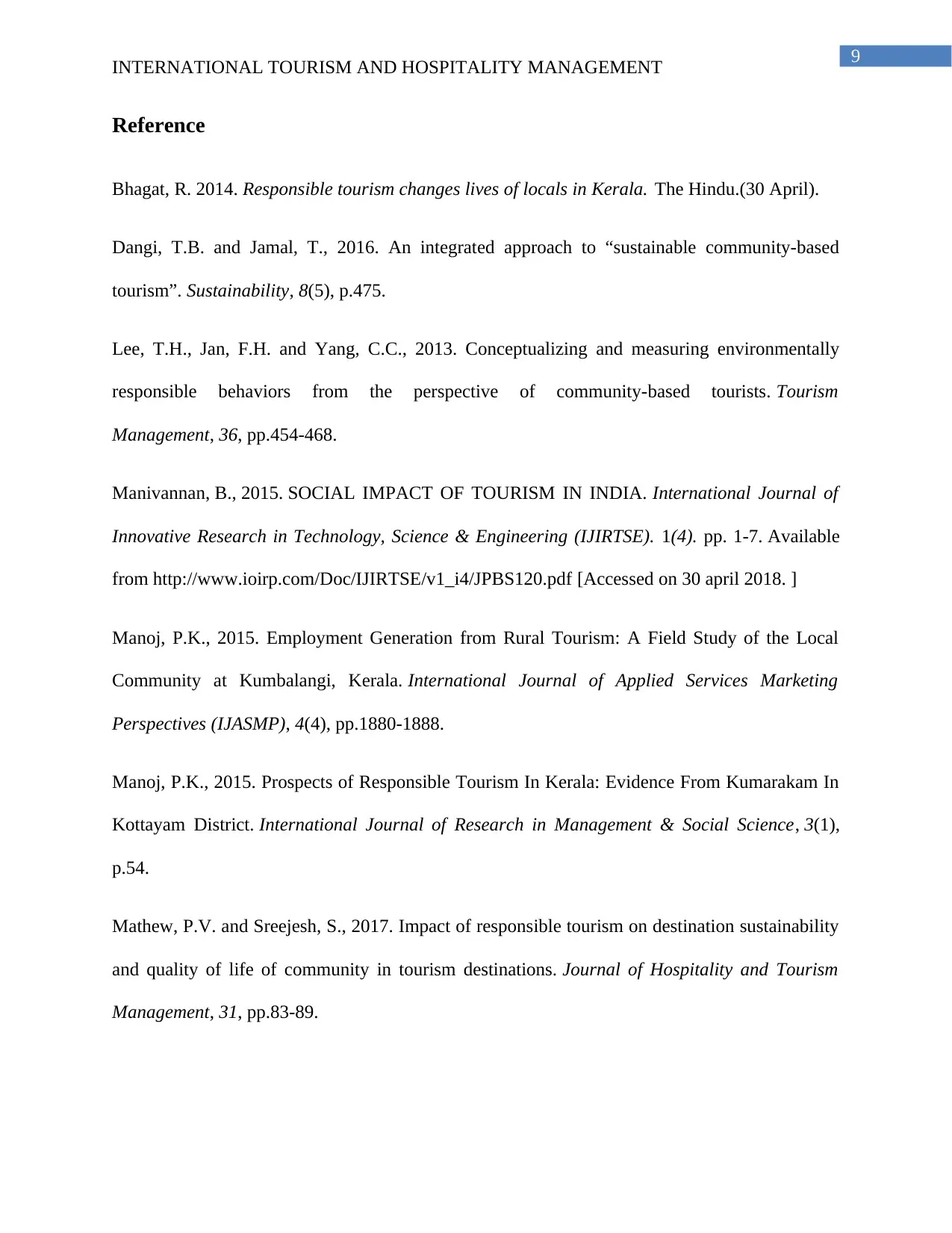
9
INTERNATIONAL TOURISM AND HOSPITALITY MANAGEMENT
Reference
Bhagat, R. 2014. Responsible tourism changes lives of locals in Kerala. The Hindu.(30 April).
Dangi, T.B. and Jamal, T., 2016. An integrated approach to “sustainable community-based
tourism”. Sustainability, 8(5), p.475.
Lee, T.H., Jan, F.H. and Yang, C.C., 2013. Conceptualizing and measuring environmentally
responsible behaviors from the perspective of community-based tourists. Tourism
Management, 36, pp.454-468.
Manivannan, B., 2015. SOCIAL IMPACT OF TOURISM IN INDIA. International Journal of
Innovative Research in Technology, Science & Engineering (IJIRTSE). 1(4). pp. 1-7. Available
from http://www.ioirp.com/Doc/IJIRTSE/v1_i4/JPBS120.pdf [Accessed on 30 april 2018. ]
Manoj, P.K., 2015. Employment Generation from Rural Tourism: A Field Study of the Local
Community at Kumbalangi, Kerala. International Journal of Applied Services Marketing
Perspectives (IJASMP), 4(4), pp.1880-1888.
Manoj, P.K., 2015. Prospects of Responsible Tourism In Kerala: Evidence From Kumarakam In
Kottayam District. International Journal of Research in Management & Social Science, 3(1),
p.54.
Mathew, P.V. and Sreejesh, S., 2017. Impact of responsible tourism on destination sustainability
and quality of life of community in tourism destinations. Journal of Hospitality and Tourism
Management, 31, pp.83-89.
INTERNATIONAL TOURISM AND HOSPITALITY MANAGEMENT
Reference
Bhagat, R. 2014. Responsible tourism changes lives of locals in Kerala. The Hindu.(30 April).
Dangi, T.B. and Jamal, T., 2016. An integrated approach to “sustainable community-based
tourism”. Sustainability, 8(5), p.475.
Lee, T.H., Jan, F.H. and Yang, C.C., 2013. Conceptualizing and measuring environmentally
responsible behaviors from the perspective of community-based tourists. Tourism
Management, 36, pp.454-468.
Manivannan, B., 2015. SOCIAL IMPACT OF TOURISM IN INDIA. International Journal of
Innovative Research in Technology, Science & Engineering (IJIRTSE). 1(4). pp. 1-7. Available
from http://www.ioirp.com/Doc/IJIRTSE/v1_i4/JPBS120.pdf [Accessed on 30 april 2018. ]
Manoj, P.K., 2015. Employment Generation from Rural Tourism: A Field Study of the Local
Community at Kumbalangi, Kerala. International Journal of Applied Services Marketing
Perspectives (IJASMP), 4(4), pp.1880-1888.
Manoj, P.K., 2015. Prospects of Responsible Tourism In Kerala: Evidence From Kumarakam In
Kottayam District. International Journal of Research in Management & Social Science, 3(1),
p.54.
Mathew, P.V. and Sreejesh, S., 2017. Impact of responsible tourism on destination sustainability
and quality of life of community in tourism destinations. Journal of Hospitality and Tourism
Management, 31, pp.83-89.
Secure Best Marks with AI Grader
Need help grading? Try our AI Grader for instant feedback on your assignments.
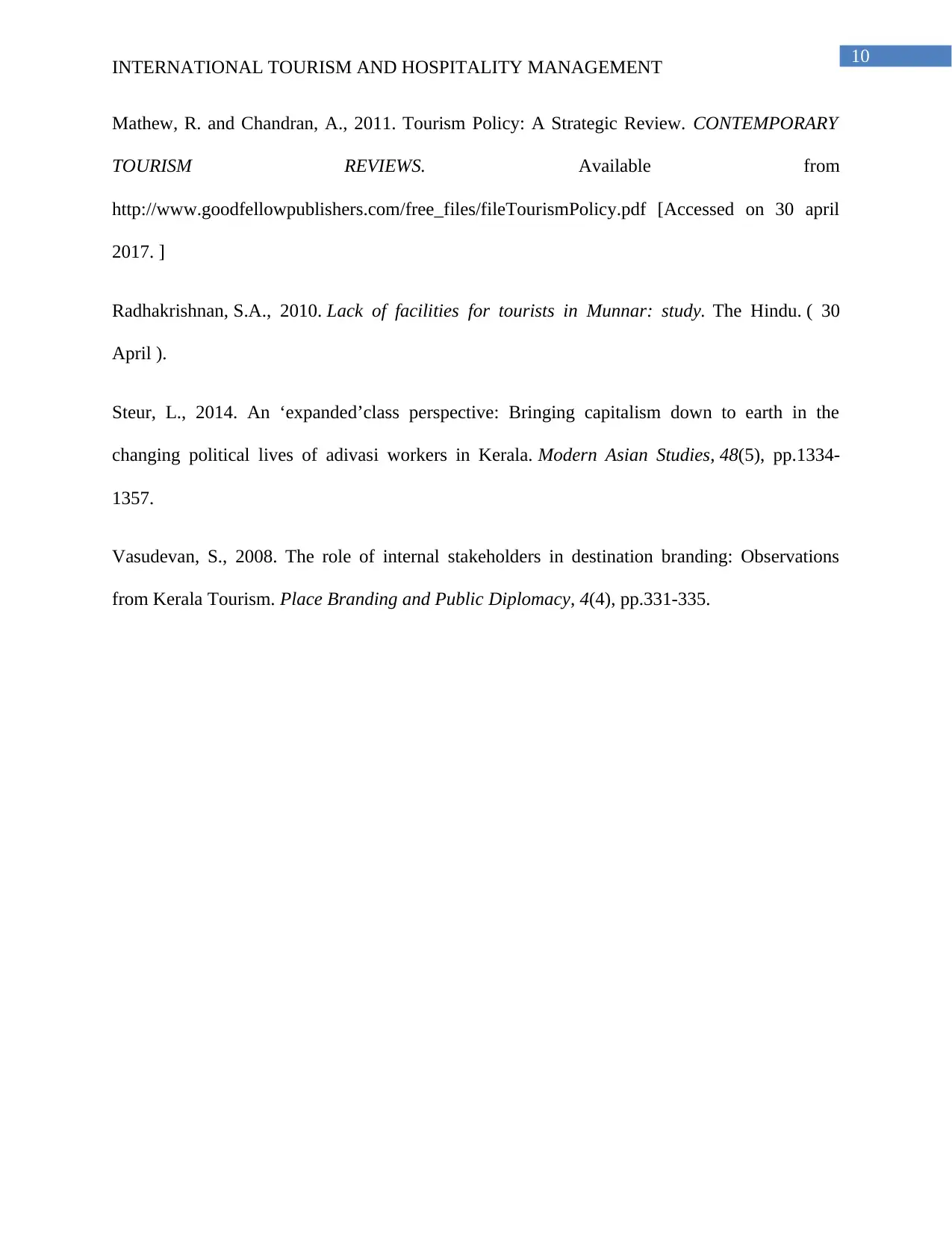
10
INTERNATIONAL TOURISM AND HOSPITALITY MANAGEMENT
Mathew, R. and Chandran, A., 2011. Tourism Policy: A Strategic Review. CONTEMPORARY
TOURISM REVIEWS. Available from
http://www.goodfellowpublishers.com/free_files/fileTourismPolicy.pdf [Accessed on 30 april
2017. ]
Radhakrishnan, S.A., 2010. Lack of facilities for tourists in Munnar: study. The Hindu. ( 30
April ).
Steur, L., 2014. An ‘expanded’class perspective: Bringing capitalism down to earth in the
changing political lives of adivasi workers in Kerala. Modern Asian Studies, 48(5), pp.1334-
1357.
Vasudevan, S., 2008. The role of internal stakeholders in destination branding: Observations
from Kerala Tourism. Place Branding and Public Diplomacy, 4(4), pp.331-335.
INTERNATIONAL TOURISM AND HOSPITALITY MANAGEMENT
Mathew, R. and Chandran, A., 2011. Tourism Policy: A Strategic Review. CONTEMPORARY
TOURISM REVIEWS. Available from
http://www.goodfellowpublishers.com/free_files/fileTourismPolicy.pdf [Accessed on 30 april
2017. ]
Radhakrishnan, S.A., 2010. Lack of facilities for tourists in Munnar: study. The Hindu. ( 30
April ).
Steur, L., 2014. An ‘expanded’class perspective: Bringing capitalism down to earth in the
changing political lives of adivasi workers in Kerala. Modern Asian Studies, 48(5), pp.1334-
1357.
Vasudevan, S., 2008. The role of internal stakeholders in destination branding: Observations
from Kerala Tourism. Place Branding and Public Diplomacy, 4(4), pp.331-335.
1 out of 11
Related Documents
Your All-in-One AI-Powered Toolkit for Academic Success.
+13062052269
info@desklib.com
Available 24*7 on WhatsApp / Email
![[object Object]](/_next/static/media/star-bottom.7253800d.svg)
Unlock your academic potential
© 2024 | Zucol Services PVT LTD | All rights reserved.





